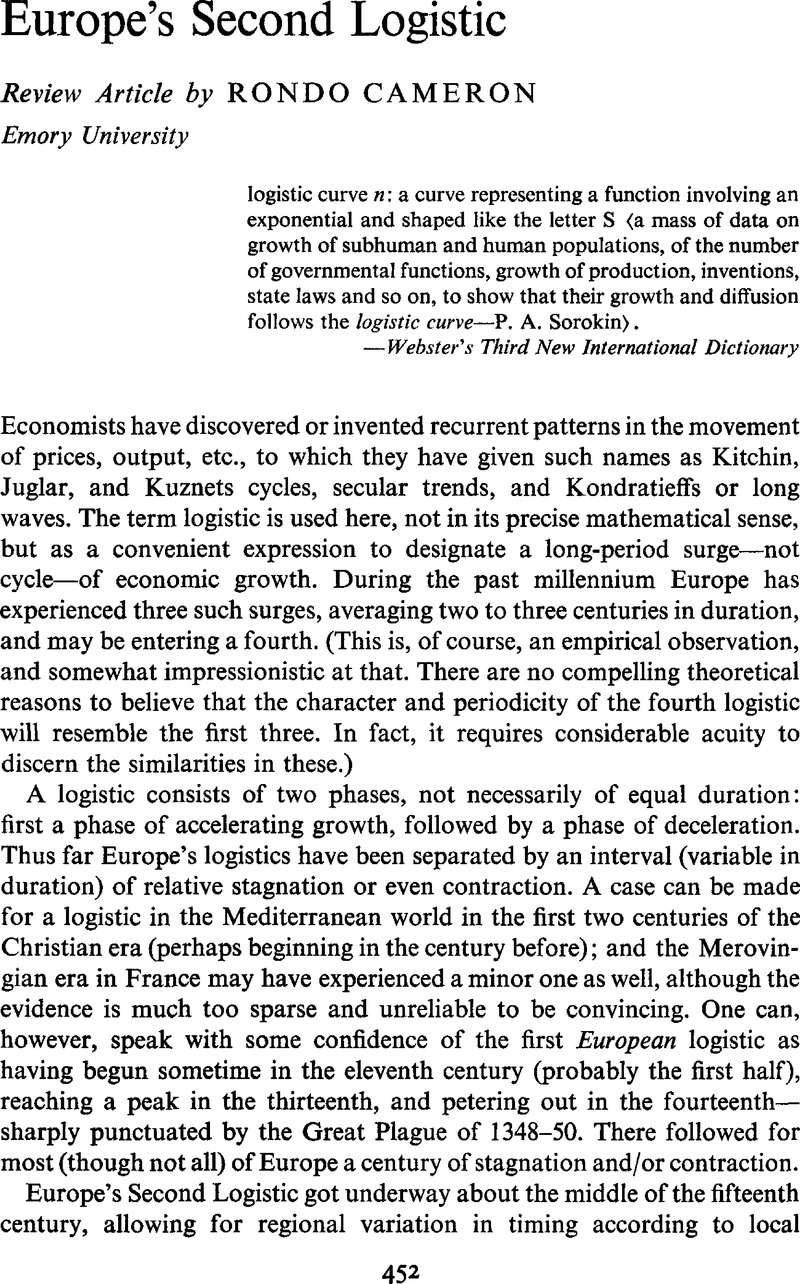Article contents
Europe's Second Logistic
Published online by Cambridge University Press: 03 June 2009
Abstract

- Type
- Review Articles
- Information
- Copyright
- Copyright © Society for the Comparative Study of Society and History 1970
References
page 453 note 1 Rich, E. E. and Wilson, C. H., eds., The Cambridge Economic History of Europe, Vol. IV, ‘The Economy of Expanding Europe in the Sixteenth and Seventeenth centuries’, (Cambridge: At the University Press, 1967), pp. xxxii, 642, $14.50.Google Scholar
page 453 note 2 Braudel, Fernand, Civilisation matirielle et capitalisme (XVe;-XVIIIe siecle), Tome 1er, (Paris: Librairie Armand Colin, 1967), pp. 463, n.p.Google Scholar
page 453 note 3 This should not be construed as an Anglo-French confrontation. Of the nine authors represented in the CEHE (one of the eight chapters has two authors), only four are English; two are French (including Braudel, co-author of the chapter on prices), two American and one a Canadian of German origin.
page 455 note 4 National income is not necessarily the best measure, but the most convenient one, since that is the way income statistics are collected. For many purposes regional income (for regions within a single nation or cutting across national borders) would be more appropriate. A French scholar has even proposed measuring continental and intercontinental incomes; see Chaunu, Pierre, ‘Histoire quantitative ou histoire sérielle’, Cahiers Vilfredo Pareto, III (1964), 165–76, and ‘Histoire serielle: bilan et perspectives’, Revue historique (1970).Google Scholar
page 455 note 5 Earlier centuries are not quite so pre-statistical as we sometimes think, but for the most part the existing statistical data have not been organized and published. Chaunu thinks that, given enough time, financial support and researchers, it will be possible to construct estimates of national income and other economic indicators for the sixteenth and seventeenth centuries. See also P. and Chaunu, H., Seville et l'Atlantique, 1504 à 1650, 11 vols. (Paris: S.E.V.P.E.N., 1955–60).Google Scholar
page 455 note 6 The very concept of national income is, of course, an intellectual construction without an objective existence. If our statistical measure of income behaves in the manner of a logistic curve—or in cycles or any other recognizable pattern—it is because some, at least, of its components, which do have an objective existence, behave in that fashion. In the long run population is one of the most important components.
page 456 note 7 Not so widely held today as fifteen years ago. A footnote informs us that Helleiner com pleted his manuscript in 1955. The long delay between completion and publication is one of the hazards of collective scholarly publishing which has been particularly trying for some of the contributors to the Cambridge Economic History.
page 456 note 8 CEHE, IV, 94.
page 456 note 9 Braudel, Civilisation, p. 19.
page 457 note 10 Ibid.
page 457 note 11 Le Roy Ladurie, E., Histoire du climat depuis l'an mil (Paris: Flammarion 1967), esp. pp. 281, 286–7.Google Scholar
page 459 note 12 CEHE, IV, 487, 575.
page 460 note 13 Rabb, Theodore K., Enterprise & Empire: Merchant and Gentry Investment in the Expansion of England, 1575–1630 (Cambridge, Mass.: Harvard University Press, 1967), pp. xiv, 420, $12.50.CrossRefGoogle Scholar
page 460 note 14 He placed on punch cards and analyzed with a computer investment data concerning more than 6,000 individuals, including all discoverable investors in joint-stock companies and all members of Parliament during this period. Well over half the volume is devoted to a description of his procedures and presentation of the basic data.
page 461 note 15 See especially his Rise of the British Coal Industry, 2 vols. (London, 1932);Google Scholar also Industry and Government in France and England, 1540–1640 (American Philosophical Socety, Memoirs, Vol. XV [1940]; reprinted by Cornell University Press, 1957); and other writings.Google Scholar
page 461 note 16 Braudel, Civilisation, p. 282.
page 461 note 17 He gives no sources for his data (probably there are none), and only the barest hint of the method of calculation. By the end of the eighteenth century numerous steam engines (both Newcomen and Watt types) were at work, and coal consumption was surely an appreciable source of energy. The horsepower attributed to sailing ships appears to be very small in relation to the other sources.
- 2
- Cited by




